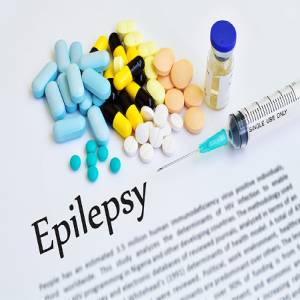
Epilepsy medications are used to treat a neurological disorder called epilepsy, which is characterized by recurring, unprovoked seizures. These seizures can cause sudden physical and mental disruptions, including loss of awareness, behavioral changes, and emotional distress. Epilepsy drugs come in different generations, including first, second, and third-generation anti-epileptic drugs (AEDs). They are available in various forms such as capsules, liquids, tablets, and syrups, and can be administered through intravenous (IV), oral, or intramuscular routes. These medications are effective in treating different types of seizures, including difficult-to-treat cases, mixed seizures, partial onset seizures, tonic-clonic seizures, and acute repetitive seizures. Epilepsy drugs help prevent life-threatening complications, have a good safety profile, are well-tolerated by patients, and minimize any negative effects on cognitive functions. Consequently, these medications are widely accessible in hospitals and pharmacies.
How Big is the Global Epilepsy Drugs Market?
The global epilepsy drugs market size reached US$ 2.16 Billion in 2022. Looking forward, IMARC Group expects the market to reach US$ 3.52 Billion by 2028, exhibiting a growth rate (CAGR) of 8.2% during 2023-2028. The rising prevalence of epilepsy, increasing incidences of brain cancer in the geriatric population, and extensive research and development (R&D) activities represent some of the key factors driving the market.
Global Epilepsy Drugs Market Trends:
The increasing prevalence of epilepsy is driven by various factors such as the rising incidence of neurological disorders, birth-related injuries, infections, substance abuse, and road injuries. This has led to a growing demand for epilepsy drugs in the market. These medications are needed to control seizures, reduce their frequency, and minimize the adverse effects associated with long-term treatments, enabling patients to resume their normal psychosocial and vocational activities. Additionally, government bodies have implemented policies to raise awareness about epilepsy, support research efforts, and provide better treatment options, thereby contributing to the growth of the global market. The aging population, which is more susceptible to critical conditions like brain cancer that can trigger seizures, is also a significant factor driving market growth. Moreover, the development of extended-release (ER) formulations that allow longer dosing intervals and improve medication efficacy and adherence by reducing fluctuations in serum levels is expected to further propel the epilepsy drugs market in the forecasted period.
Download your free sample brochure: https://www.imarcgroup.com/epilepsy-drugs-market/requestsample
What is included in market segmentation?
The report has segmented the market into the following categories:
Generation Type Insights
- First Generation Drugs
- Phenytoin
- Carbamazepine
- Oxcarbazepine
- Valproate
- Ethosuximide
- Primidone
- Phenobarbital
- Second Generation Drugs
- Levetiracetam
- Lamotrigine
- Topiramate
- Pregabalin
- Rufinamide
- Zonisamide
- Third Generation Drugs
- Lacosamide
- Perampanel
- Eslicarbazepine Acetate
- Ezogabine/Retigabine
The report has also provided a detailed breakup and analysis of the epilepsy drugs market based on the generation type. This includes first generation drugs (phenytoin, carbamazepine, oxcarbazepine, valproate, ethosuximide, primidone, and phenobarbital), second generation drugs (levetiracetam, lamotrigine, topiramate, pregabalin, rufinamide, and zonisamide), and third generation drugs (lacosamide, perampanel, eslicarbazepine acetate, and ezogabine/retigabine). According to the report, second generation drugs represented the largest segment.
Anti-Epileptics Drugs Type Insights
- Narrow-Spectrum AEDs
- Broad-Spectrum AEDs
A detailed breakup and analysis of the epilepsy drugs market based on the anti-epileptics drugs type has also been provided in the report. This includes narrow and broad-spectrum AEDs. According to the report, broad-spectrum AEDs accounted for the largest market share.
Distribution Channel Insights
- Hospital Pharmacy
- Pharmacy Stores
- Others
A detailed breakup and analysis of the epilepsy drugs market based on the distribution channel has been provided in the report. This includes hospital pharmacy, pharmacy stores, and others. According to the report, hospital pharmacy accounted for the largest market share.
Regional Insights:
- North America
- United States
- Canada
- Asia-Pacific
- China
- Japan
- India
- South Korea
- Australia
- Indonesia
- Others
- Europe
- Germany
- France
- United Kingdom
- Italy
- Spain
- Russia
- Others
- Latin America
- Brazil
- Mexico
- Others
- Middle East and Africa
The report has also provided a comprehensive analysis of all the major regional markets that include North America (the United States and Canada); Asia Pacific (China, Japan, India, South Korea, Australia, Indonesia, and others); Europe (Germany, France, the United Kingdom, Italy, Spain, Russia, and others); Latin America (Brazil, Mexico, and others); and Middle East and Africa. According to the report, North America was the largest market for epilepsy drugs. Some of the factors driving the North America epilepsy drugs market growth include increasing burden of epilepsy, rising awareness campaigns, launching of new products, etc.
Who are the key players operating in the industry?
The report covers the major market players including:
Abbott Laboratories, Alkem Laboratories Limited, Bausch Health Companies Inc., Eisai Co. Ltd., GSK plc, H. Lundbeck A/S, Jazz Pharmaceuticals plc, Novartis AG, Pfizer Inc., Sunovion Pharmaceuticals Inc. (Sumitomo Dainippon Pharma Co. Ltd.), UCB S.A., etc.
Browse Other Reports:-
Brain Monitoring Market Size 2023-2028
Cord Blood Banking Services Market Size reach US$ 3.1 Billion by 2028
Diabetes Care Devices Market Size reach US$ 47.3 Billion by 2028
Contact Information:
IMARC Group 134 N 4th St. Brooklyn, NY 11249, USA USA: +1-631-791-1145 | Asia: +91-120-433-0800 Email: [email protected] Follow us on Twitter: @imarcglobal LinkedIn: https://www.linkedin.com/company/imarc-group/mycompany/
Tags:
IPS, Extended Distribution, iCN Internal Distribution, Research Newswire, English

